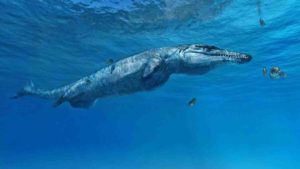
The little-studied specimen – acquired by the museum in 1875 – was identified as a new species based on distinctive features of its skull, lower jaw and, in particular, its teeth.
The study, published in the Journal of Systematic Palaeontology, was carried out in collaboration with the Natural History Museum, London. The research was funded by Marie Sklodowska-Curie Actions.
Davide Foffa, a PhD student in the University of Edinburgh’s School of GeoSciences, who led the study, said: “It’s not the prettiest fossil in the world, but the Melksham Monster tells us a very important story about the evolution of these ancient crocodiles and how they became the apex predators in their ecosystem. Without the amazing preparation work done by our collaborators at the Natural History Museum, it would not have been possible to work out the anatomy of this challenging specimen.”
Dr Steve Brusatte, of the University of Edinburgh’s School of GeoSciences, who was involved in the study, said: “The Melksham Monster would have been one of the top predators in the oceans of Jurassic Britain, at the same time that dinosaurs were thundering across the land.”
Mark Graham, Senior Fossil Preparator at the Natural History Museum, said: “The specimen was completely enclosed in a super-hard rock nodule with veins of calcite running through, which had formed around it during the process of fossilisation. This unyielding matrix had to be removed by force, using carbon steel tipped chisels and grinding wheels encrusted with industrial diamonds. The work took many hours over a period of weeks, and great care had to be taken to avoid damaging the skull and teeth as they became exposed. This was one tough old croc in life and death!”
Note: The above post is reprinted from materials provided by University of Edinburgh.










